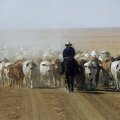A world-first cattle vaccine based on nanotechnology could provide protection from the *Bovine Viral Diarrhoea Virus (BVDV), which costs the Australian cattle industry tens of millions of dollars in lost revenue each year.
The new BVDV vaccine that constitutes a protein from the virus loaded on nanoparticles, has been shown to produce an immune response against the industry’s most devastating virus.
A group of Brisbane scientists has shown that the BVDV nanoformulation can be successfully administered to animals without the need of any additional helping agent making a new ‘nanovaccine’ a real possibility for Australian cattle industries.
Scientists Dr Neena Mitter and Dr Tim Mahony from the Queensland Alliance for Agriculture and Food Innovation (QAAFI) a UQ Institute recently established in partnership with the Queensland Department of Employment Economic Development and Innovation (DEEDI), partnered with nanotechnology experts Professor Max Lu and Associate Professor Shizang Qiao from the UQ Australian Institute of Bioengineering & Nanotechnology (AIBN) to develop the vaccine.
Dr Neena Mitter said the multidisciplinary team applied the latest in nanotechnology to develop a safe and effective vaccine that has the potential to be administered more readily and cost effectively than traditional vaccines by using nanoparticles as the delivery vehicles.
“The vaccine is exciting as it could feasibly enable better protection against the virus, can be stored at room temperature and has a long shelf life,” said Dr Mitter.
According to Dr Mahony, BVDV is of considerable concern with regard to the long-term profitability of cattle industries across Australia. Cattle producers can experience productivity losses of between 25 and 50 per cent following discovery of BVDV in previously uninfected herds.
“In Queensland alone the beef cattle industry is worth approximately $3.5 billion per year and the high-value feedlot sector experiences losses of over $60 million annually due to BVDV-associated illness,” he said.
Further trials of the nanovaccine will now be conducted with plans to develop a commercial veterinary product in the near future.
BVDV Background
Bovine Viral Diarrhoea Virus (BVDV), also known as Bovine Pestivirus, is a viral infection of cattle present in feedlots and beef and dairy herds in Australia. Clinical signs exhibited by infected animals include diarrhoea, respiratory infections, infertility and abortion.
Persistently infected (PI) animals are the principal way BVDV is spread and maintained within a herd.
Infection of a foetus with BVDV between 0 and 125 days of gestation can result in the birth of a PI animal that carries the virus for life and is responsible for spread of the virus.
PI animals shed and spread the BVDV virus through saliva, nasal secretions, faeces, urine, tears, milk, semen, vaginal discharges, placenta and birth fluid. It can take as little as 1 hour of direct contact with a PI animal to transmit BVDV to an uninfected animal.
For more information, see the QAAFI website at www.qaafi.uq.edu.au/ or the BVDV Australia website at www.bvdvaustralia.com.au
Media: Julie Lloyd, QAAFI Communication Manager, 0415 799 890.
.jpg)











